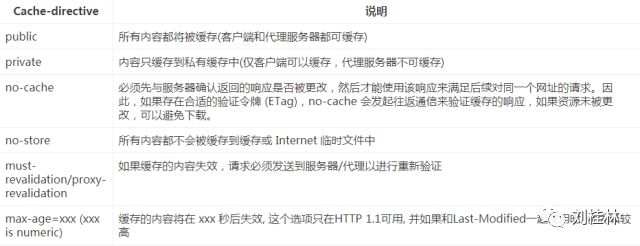《OkHttp源码分析》之 OkHttp的缓存管理
Posted 刘桂林
tags:
篇首语:本文由小常识网(cha138.com)小编为大家整理,主要介绍了《OkHttp源码分析》之 OkHttp的缓存管理相关的知识,希望对你有一定的参考价值。
本文作者

12
1-2018
Mirs_sir
博客:http://my.csdn.net/a109340
声明:本文由作者 Mirs_sir 授权发布,未经原作者允许请勿转载
看到上面蓝色字了吗,点下吧
感谢 Mirs_sir 为我们带来OkHttp源码分析系列文章,目录如下:
1.Http请求原理
2.OkHttp的简单使用
3.OkHttp的初始化
4.OkHttp请求流程分析
5.OkHttp的请求拦截链
6.OkHttp请求调度的分析
7.OkHttp的缓存管理
8.深入源码理解HashMap、LinkedHashMap,DiskLruCache
日更一篇,敬请期待哦
OkHttp的缓存管理
Cache Management for OkHttp
之前有讲到, Http头里面有个Cache-Control 的字段,这个字段就是来处理缓存的,我们先来了解一下Cache-Control
1
Cache-Control的运用
Cache-Control : cache-directive

Last-Modified/E-Tag
Last-Modified 实体头部字段值通常用作一个缓存验证器。简单来说,如果实体值在 Last-Modified 值之后没有被更改,则认为该缓存条目有效。ETag 响应头部字段值是一个实体标记,它提供一个 “不透明” 的缓存验证器。这可能在以下几种情况下提供更可靠的验证:不方便存储修改日期;HTTP 日期值的 one-second 解决方案不够用;或者原始服务器希望避免由于使用修改日期而导致的某些冲突。
由于开启缓存讲道理应该是服务端配置的,但是我们现在是研究用,所以自己在本地写个NetworkInterceptor加进去
代码如下:
public class CacheInterceptor implements Interceptor {
@Override
public Response intercept(Chain chain) throws IOException {
Request request = chain.request();
Response response = chain.proceed(request);
Response response1 = response.newBuilder()
.removeHeader(“Pragma”)
.removeHeader(“Cache-Control”)
.header(“Cache-Control”,”max-age=”+ 3600*24*30)
.build();
return response1;
}
}
在这边我们手动的在返回的header加入Cache-Control,下面 我们来分析他的流程
2
OkHttp缓存管理
如果要支持缓存的话 要在初始化OkHttpClient的时候进行相应的设置,例如
public class TestMain {
private static final long cacheSize = 1024 * 1024 * 20;//缓存文件最大限制大小20M
private static String cachedirectory = "/Users/liuxiaohu/Desktop" + "/caches"; //设置缓存文件路径
private static Cache cache = new Cache(new File(cachedirectory), cacheSize); //
public static void main(String[] args) {
OkHttpClient okHttpClient = new OkHttpClient.Builder()
.cache(cache)
.addNetworkInterceptor(new CacheInterceptor())
.build();
(..... 省略一大堆代码)
}
}
这边的话我们初始化cache的大小,目录等,然后设置进去,注意.addNetworkInterceptor(new CacheInterceptor()) 这边是测试的 讲道理需要后台配置
还在等什么呢?请求搞起,目地已经非常明确了 就是CacheInterceptor 按照以往的姿势,看他的初始化和intercept 方法
//初始化在 RealCall 初始化拦截链那边
//ReaCll.java
interceptors.add(new CacheInterceptor(client.internalCache()));
//internalCache 在 OkHttpClient.java 里 ,如果你构建的时候用的是cahe构建的,那这边返回的就是cache
InternalCache internalCache() {
return cache != null ? cache.internalCache : internalCache;
}
//这边的cache就是你实例化的Cache Cache.java 这个类主要就是负责操作缓存,这边知道cache后我们来看CacheInterceptor#intercept(Chain chain)
@Override public Response intercept(Chain chain) throws IOException {
Response cacheCandidate = cache != null
? cache.get(chain.request())
: null;
//记录当前时间戳
long now = System.currentTimeMillis();
CacheStrategy strategy = new CacheStrategy.Factory(now, chain.request(), cacheCandidate).get();
Request networkRequest = strategy.networkRequest;
Response cacheResponse = strategy.cacheResponse;
//如果缓存不为空,添加响应计数
if (cache != null) {
cache.trackResponse(strategy);
}
if (cacheCandidate != null && cacheResponse == null) {
closeQuietly(cacheCandidate.body()); // The cache candidate wasn't applicable. Close it. 缓存候选者不适用。关闭它
}
// If we're forbidden from using the network and the cache is insufficient, fail.如果我们被禁止使用网络并且缓存不够,则失败。
if (networkRequest == null && cacheResponse == null) {
return new Response.Builder()
.request(chain.request())
.protocol(Protocol.HTTP_1_1)
.code(504)
.message("Unsatisfiable Request (only-if-cached)")
.body(Util.EMPTY_RESPONSE)
.sentRequestAtMillis(-1L)
.receivedResponseAtMillis(System.currentTimeMillis())
.build();
}
// If we don't need the network, we're done.如果我们不需要网络,我们就完成了
if (networkRequest == null) {
return cacheResponse.newBuilder()
.cacheResponse(stripBody(cacheResponse))
.build();
}
Response networkResponse = null;
try {
networkResponse = chain.proceed(networkRequest);
} finally {
// If we're crashing on I/O or otherwise, don't leak the cache body.如果I / O或其他正在崩溃不要泄漏缓存主体。
if (networkResponse == null && cacheCandidate != null) {
closeQuietly(cacheCandidate.body());
}
}
// If we have a cache response too, then we're doing a conditional get.如果我们也有缓存响应,那么我们正在做一个条件去获取。
if (cacheResponse != null) {
if (networkResponse.code() == HTTP_NOT_MODIFIED) {
Response response = cacheResponse.newBuilder()
.headers(combine(cacheResponse.headers(), networkResponse.headers()))
.sentRequestAtMillis(networkResponse.sentRequestAtMillis())
.receivedResponseAtMillis(networkResponse.receivedResponseAtMillis())
.cacheResponse(stripBody(cacheResponse))
.networkResponse(stripBody(networkResponse))
.build();
networkResponse.body().close();
// Update the cache after combining headers but before stripping the
// Content-Encoding header (as performed by initContentStream()).
//在组合头后,但在剥离Content-Encoding头(由initContentStream()执行)之前更新缓存。
cache.trackConditionalCacheHit();
cache.update(cacheResponse, response);
return response;
} else {
closeQuietly(cacheResponse.body());
}
}
Response response = networkResponse.newBuilder()
.cacheResponse(stripBody(cacheResponse))
.networkResponse(stripBody(networkResponse))
.build();
if (cache != null) {
if (HttpHeaders.hasBody(response) && CacheStrategy.isCacheable(response, networkRequest)) {
// Offer this request to the cache.将此请求提供给缓存
CacheRequest cacheRequest = cache.put(response);
return cacheWritingResponse(cacheRequest, response);
}
if (HttpMethod.invalidatesCache(networkRequest.method())) {
try {
cache.remove(networkRequest);
} catch (IOException ignored) {
// The cache cannot be written.缓存无法写入。
}
}
}
return response;
}
总的来说流程还是比较简单的,我们来整理一下
intercept中调用了Cache的get方法,传入的是当前的request,获取到缓存
从缓存中获取请求和返回,如果当前缓存不为空,则添加Cache的计数
如果缓存不适用,关闭当前的缓存
如果我们被禁止使用网络并且缓存不够,则失败,返回code为504。
如果网络请求为null,那么久完成这次请求 ,返回从缓存中读取的返回体
如果上面都没有,那么走真正的网络请求。
然后判断是否有缓存,如果有,写入缓存,返回
3
同类文章
一、
二、
三、
四、
五、
六、

刘某人程序员
个人微信:android_LiuGuiLin
新浪微博:@刘某人程序员
看看我的分享
长按二维码关注
以上是关于《OkHttp源码分析》之 OkHttp的缓存管理的主要内容,如果未能解决你的问题,请参考以下文章